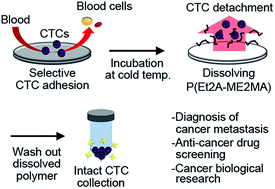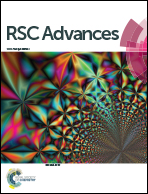Adhesion-based simple capture and recovery of circulating tumor cells using a blood-compatible and thermo-responsive polymer-coated substrate†
Abstract
Circulating tumor cells (CTCs) have been a focus of study for metastatic cancer diagnostics, in in vitro anti-cancer drug screening to decide the chemotherapeutic course, and cancer biology research. For these purposes, there have been efforts made to collect CTCs from the peripheral blood of cancer patients. Here, we explore the possibility of collecting CTCs using blood-compatible and thermo-responsive poly(2-(2-ethoxyethoxy) ethyl acrylate-co-2-(2-methoxyethoxy) ethyl methacrylate) (P(Et2A-Me2MA)) through adhesion and detachment by incubation under a lower critical solution temperature of P(Et2A-Me2MA). A P(Et2A-Me2MA)-coated substrate is dissolved by incubation under 15 °C. A P(Et2A-Me2MA)-coated substrate can suppress platelet adhesion whereas it allows the cancer cells to adhere by an epithelial cell adhesion molecule (EpCAM) expression-independent mechanism. These results suggest that cancer cells can specifically adhere to a P(Et2A-Me2MA)-coated substrate, which can be used to isolate CTCs from peripheral blood. Moreover, approximately 90% of the adherent cells can be detached by incubation at 10 and 15 °C for 30 and 90 min, respectively. The collected cells can be cultured healthily in the presence of dissolved P(Et2A-Me2MA), suggesting that the cytotoxicity of P(Et2A-Me2MA) is low. In conclusion, P(Et2A-Me2MA) is suitable for the development of devices that collect intact CTCs via an adhesion-based method.


 Please wait while we load your content...
Please wait while we load your content...